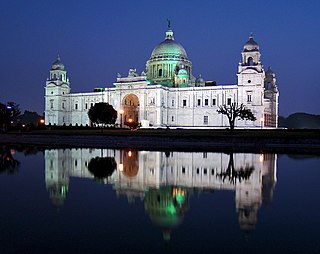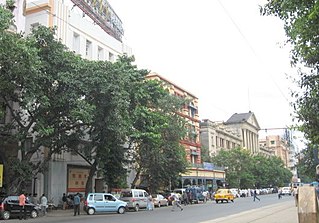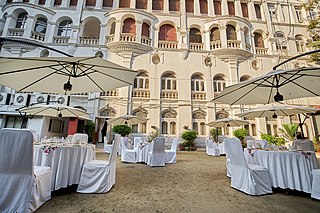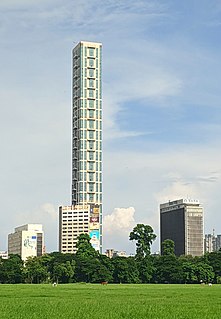
Kolkata is the capital of the Indian state of West Bengal. Located on the eastern bank of the Hooghly River, the city is approximately 80 kilometres (50 mi) west of the border with Bangladesh. It is the primary business, commercial, and financial hub of Eastern India and the main port of communication for North-East India. According to the 2011 Indian census, Kolkata is the seventh-most populous city in India, with a population of 4.5 million residents within the city limits, and a population of over 14.1 million residents in the Kolkata Metropolitan Area. It is the third-most populous metropolitan area in India. In 2021, Kolkata metropolitan area crossed 15 million registered voters. The Port of Kolkata is India's oldest operating port and its sole major riverine port. Kolkata is regarded as the Cultural Capital of India.

The Maidan, also referred to as the Brigade Parade Ground, is a large public park and urban green space in the center of Kolkata, India. With a total area of 988 acres (4.0 km2), it is the largest urban park in Asia. It is a vast stretch of field that includes numerous sporting grounds, including the famous cricketing venue Eden Gardens, several football stadiums and the Kolkata Race Course. The Maidan is also dotted with many statues and architectural works, the most notable being the Victoria Memorial. Due to the freshness and greenery it provides to the metropolis, it has been referred to as the "lungs of Kolkata".

Esplanade is a neighbourhood of Central Kolkata, in Kolkata district in the Indian state of West Bengal. This is not a conventional esplanade in the sense that the place is not exactly situated alongside a waterbody. However, the Ganga river (Ganges), also known as Hooghly river, flows nearby.
Chowringhee Road, located in the Chowringhee neighbourhood of Kolkata, is the arterial road running from the eastern fringes of Esplanade southwards up to the crossing with Lower Circular Road, in the city of Kolkata, West Bengal, India. It is the single most important road of the metropolis of Kolkata. It was officially renamed as Jawaharlal Nehru Road after Jawaharlal Nehru, India's first Prime Minister, but the original name Chowringhee Road is used commonly.

Park Street, officially known as Mother Teresa Sarani, is a famous thoroughfare in downtown Kolkata, India. The street runs through what was a deer park of Sir Elijah Impey, Chief Justice of the Supreme Court in Calcutta from 1773 to 1789, hence the earlier name. Its current official name was given by Kolkata Municipal Corporation in honour of Mother Teresa. It's located in Central Kolkata.

Kolkata, India, is largely inhabited by the ethnic community of the native Bengali Hindu respectively. According to a report by the Indian Statistical Institute owned by the Government of India, the Kolkata city had a population of 4.5 million as of 2011 out of which the population of Bengalis in Kolkata is almost 61% which comprised the majority of the city's population, whereas ethnic groups like Marwaris, Biharis and Urdu-speaking Muslims together forming 37% of the population which comes under the category of large minorities. Other Various micro-minortiy communities of Kolkata include as far as concerned follows -: Sindhi people, Pathan people, Marathi people, Odia people, Gujarati people, Kashmiri people, Punjabi people, Nepalis, Telugus, Tamil, Anglo-Indian, Iraqis, Jewish, Armenian, Tibetan, Greek, Parsi, Chinese, and Iraqi people.

B.B.D. Bagh, formerly called Tank Square and then Dalhousie Square, is the shortened version for Benoy-Badal-Dinesh Bagh. It is the seat of power of the state government, as well as the central business district of Kolkata in Kolkata district in the Indian state of West Bengal.

Raj Bhavan is the official residence of the governor of West Bengal, located in Kolkata, the capital of the Indian state of West Bengal. Built in 1803, it was known as Government House before the Indian independence.

Chitpur is a neighbourhood in North Kolkata in Kolkata district in the Indian state of West Bengal. Sometimes, the entire area along Chitpur Road is referred to as Chitpur, although the various localities have distinctive names.

Janbazar is a neighbourhood of Central Kolkata, in Kolkata district in the Indian state of West Bengal. The two century-old house of Rani Rashmoni, the central attraction in Janbazar, is still used by descendants in the family.

Dharmatala is a neighbourhood of Central Kolkata, in Kolkata district in the Indian state of West Bengal. Dharmatala Street has been renamed after Lenin as Lenin Sarani but the neighbourhood up to Wellington Square continues to be referred as Dharmatala. It is a busy commercial area that had come up with the growth of Calcutta during the British Raj and is thus one of the repositories of history in the city.

Mahatma Gandhi Road or M.G. Road, formerly known as Harrison Road, is a principal East-West thoroughfare in Kolkata, the capital of the Indian state of West Bengal. M.G. Road makes the boundary of North and Central Kolkata. In 1889 this was the first street of the city to be lit by electricity.

Strand Road, also referred to as The Strand, is a major thoroughfare in downtown Kolkata, India. Running along the east bank of the Hooghly River, the road connects Bagbazar to Prinsep Ghat via the threshold of Howrah Bridge. South of Prinsep Ghat, Strand Road becomes St. Georges Gate Road.

The Bengal Club is a social and business club in Kolkata, India. Founded in 1827, the club is the oldest social club in India. When Kolkata was the capital of British India, the club was considered to be the "unofficial headquarters of the Raj". The club is nowadays known for its old-world ambience and patronage among contemporary social and corporate elites, and is among a small number of Indian clubs featured in the elite list of the "Platinum Clubs of the World".

Shakespeare Sarani is a street running in the central business district of Kolkata, India, from Park Circus to Chowringhee Road. It was renamed on 24 April 1964 after William Shakespeare, to mark the fourth birth centenary of the legendary playwright. It is considered to be a high street of Kolkata with many commercial establishments, offices, shops and restaurants situated by the road. It intersects with other important roads in the CBD like Acharya Jagadish Chandra Bose Road, Camac Street, Loudon Street and Rawdon Street. Few other roads like, Little Russel Street, Wood Street, Picasso Bithi & Lord Sinha Road criss-crosses or merge into Shakespeare Sarani from North or South. West of Birla Planetarium crossing, Shakespeare Sarani becomes Queen's Way.

Metropolitan Building is the number 46.26 building on Chowringhee Road in Kolkata near Esplanade. Formerly known as the Whiteway Laidlaw department store, it was a famous department store in Calcutta during the British Rule in India. This neo-baroque emporium—with domes, a clock tower and arched recessed windows—exemplifies fashionable shopping during the British Raj in British India.

The 42 is a residential skyscraper in Kolkata, in the state of West Bengal, India. It is located in Chowringhee, the central business district of the city, between Tata Centre and Jeevan Sudha. It was first proposed in 2008 but construction was delayed for nearly two years. Construction of the building was topped off in 2019, making it the tallest building in the country at that time.

Magen David, or the Shield of David, Synagogue is located at the junction of Brabourne Road and Canning Street in Kolkata. Magen David is the second operating synagogue in Kolkata, the other is the Beth El Synagogue at Pollock Street.

David Joseph Ezra was a leading merchant, property developer and communal leader of the Baghdadi Jewish community in Kolkata, India. He was one of the key developers behind nineteenth century Kolkata, and was responsible for many of its most celebrated Victorian buildings and synagogues.

























